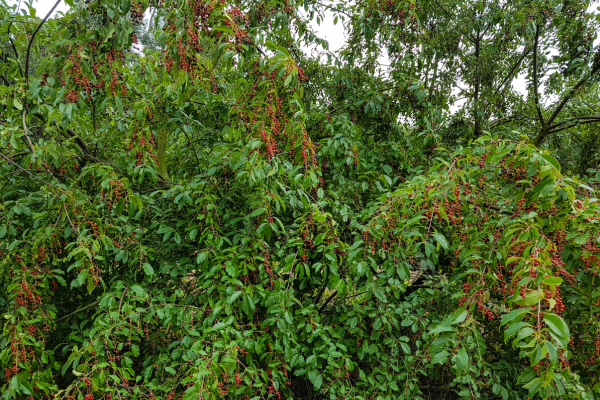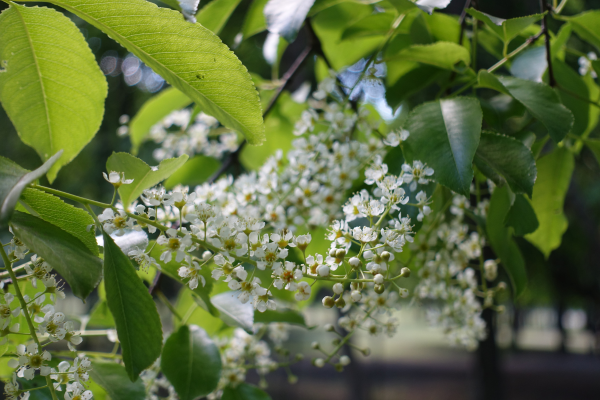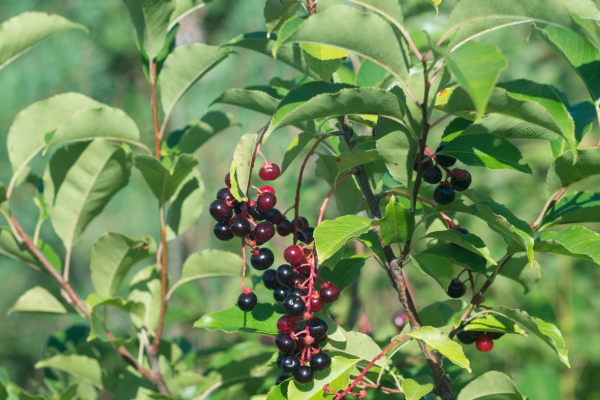Scientific name: Prunus serotina
Prunus = Classical Latin name for a plum tree. This genus is large, with approximately 430 species, containing a wide range of fruiting trees such as peaches, apricots, cherries, etc.
serotina = From the Latin word serotinus, meaning “late” or “late in development” which could refer to this species having a later flowering time then other species within the genus.
Black cherry can be seen growing across southern Ontario. Its fruit makes this tree important for birds and small mammals. The small (8-10 centimeter) berries, that ripen in late August to early September are edible, though somewhat bitter. However, all other parts of this tree contain hydrocyanic acid, a toxic chemical compound that has the capability to harm humans and cattle. Oddly, the leaves of this tree are said to smell like almonds when crushed.
Black cherry can tolerate a broad range of moisture levels and soil types. However, it is shade intolerant, so plant in full sun. Black cherry can grow up to 22 meters in height, though when grown in colder climates, will become shorter and more shrub-like. This tree is a popular choice as an ornamental due to its attractive white flowers, that grow in elongated clusters.
Black cherry wood was once a popular choice for carpentry due to its workability and unique reddish-brown colour. It was commonly used in cabinetry, interior finishes (such as flooring and trim), furniture, musical instruments, toys, and scientific instruments. However, over time the wood has become scarcer. The edible berries have been used to flavour alcoholic beverages like rum and brandy and are also made into jam and jelly. In the past, early settlers used the leaves and inner bark to create tonics, cough syrup and sedatives due to the compounds present acting to quell spasms in muscles such as the lining of the bronchioles (tiny branching air tubes in the lungs). This, however, is not recommended now. To see how to make your own jam using this fruit see "Wild Cherry Jam"
The signs and tags at the Edible Forest are in place for educational purposes and should not necessarily be used for identification. Visitors may identify, consume, forage, and prepare plants from the Edible Forest at their own risk. Visitors should be aware that ingesting toxic or poisonous plants could lead to life-threating injuries or allergic reactions. In the event of an emergency, call 911.
Sources:
CasaBio. 2022. Species Prunus serotina. [online] Available: https://casabio.org/taxa/prunus-serotina
OMNR, 2022. Ontario Ministry of Natural Resources: Ontario Tree Atlas. [online] Available: https://www.ontario.ca/page/black-cherry
OMNR. Ontario's Tree Atlas. [online] Available: https://pecmastergardeners.ca/wp-content/uploads/2020/07/Ontarios-Tree-Atlas.pdf
University of Guelph. The Arboretum - Black Cherry - Prunus serotina. [online] Available: https://arboretum.uoguelph.ca/thingstosee/trees/blackcherry
%20938-3611%20info%40rrca_on_ca%20rrca_on_catrees%20(400%20%C3%97%20200%20px)%20(1).jpg)


 Black cherry trees have an oval silhouette with low branches that generally droop and touch the ground.
Black cherry trees have an oval silhouette with low branches that generally droop and touch the ground..png)
 The flowers of black cherry grow in small bunches in the spring after its leaves have fully developed.
The flowers of black cherry grow in small bunches in the spring after its leaves have fully developed. The cherries produced by this tree grow in clusters. They develop in late August to early September.
The cherries produced by this tree grow in clusters. They develop in late August to early September.